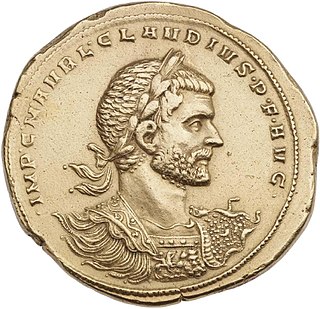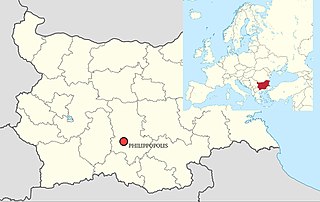Related Research Articles

The Battle of Abritus, also known as the Battle of Forum Terebronii, occurred near Abritus in the Roman province of Moesia Inferior in the summer of 251. It was fought between the Romans and a federation of Gothic and Scythian tribesmen under the Gothic king Cniva. The Roman army of three legions was soundly defeated, and Roman emperors Decius and his son Herennius Etruscus were both killed in battle. They became the first Roman emperors to be killed by a foreign enemy. It was one of the worst defeats suffered by the Roman Empire against the Germanic tribes, rated by the Roman historian Ammianus Marcellinus as on par with the Battle of the Teutoburg Forest in 9 AD, the Marcomannic invasion of Roman Italy in 170, and the Battle of Adrianople in 378.

Valens was Roman emperor from 364 to 378. He was the younger brother of the emperor Valentinian I, who gave Valens the eastern half of the Roman Empire to rule. Before 364, Valens had a largely unremarkable military career. In 378, Valens was defeated and killed at the Battle of Adrianople against the invading Goths, which astonished contemporaries and marked the beginning of barbarian encroachment into Roman territory.

Aurelian was a Roman emperor, who reigned during the Crisis of the Third Century, from 270 to 275. As emperor, he won an unprecedented series of military victories which reunited the Roman Empire after it had nearly disintegrated under the pressure of barbarian invasions and internal revolts.

Marcus Aurelius Claudius "Gothicus", also known as Claudius II, was Roman emperor from 268 to 270. During his reign he fought successfully against the Alemanni and decisively defeated the Goths at the Battle of Naissus. He died after succumbing to a "pestilence", possibly the Plague of Cyprian that had ravaged the provinces of the Empire.

Valerian was Roman emperor from 253 to spring 260 AD. He persecuted Christians and was later taken captive by the Persian emperor Shapur I after the Battle of Edessa, becoming the first Roman emperor to be captured as a prisoner of war, causing shock and instability throughout the Roman Empire. The unprecedented event and the unknown fate of the captured emperor generated a variety of different reactions and "new narratives about the Roman Empire in diverse contexts".

Gaius Messius Quintus Traianus Decius, sometimes translated as Trajan Decius or Decius, was the emperor of the Roman Empire from 249 to 251.

Philip the Arab was Roman emperor from 244 to 249. He was born in Aurantis, Arabia, in a city situated in modern-day Syria. After the death of Gordian III in February 244, Philip, who had been Praetorian prefect, achieved power. He quickly negotiated peace with the Persian Sassanid Empire and returned to Rome to be confirmed by the senate. During his reign, the city of Rome celebrated its millennium.

Gaius Vibius Trebonianus Gallus was Roman emperor from June 251 to August 253, in a joint rule with his son Volusianus.

Marcus Aemilius Aemilianus, also known as Aemilian, was Roman emperor for three months in 253.

Quintus Herennius Etruscus Messius Decius was briefly Roman emperor in 251, ruling jointly under his father Decius. His father was proclaimed emperor by his troops in September 249 while in Pannonia and Moesia, in opposition to Emperor Philip the Arab. Decius defeated Philip in battle, and was then proclaimed emperor by the Roman Senate. Herennius Etruscus was elevated to Caesar in 250, then further raised to Augustus in May 251. When the Goths, under Cniva, invaded the Danubian provinces, Herennius Etruscus was sent with a vanguard, followed by the main body of Roman troops, led by Decius. They ambushed Cniva at the Battle of Nicopolis ad Istrum in 250, routing him, before being ambushed and routed themselves at the Battle of Beroe. Herennius Etruscus was killed in the Battle of Abritus the following year, alongside his father. After the deaths of both emperors, Trebonianus Gallus, who had been governor of Moesia, was elected emperor by the remaining Roman forces.

Hostilian was briefly Roman emperor in 251. Hostilian was born to Decius and Herennia Etruscilla at an unknown date and elevated to caesar in 250 by Decius. After Decius and Herennius Etruscus, Hostilian's brother, were killed at the Battle of Abritus, an ambush by the Goths, Trebonianus Gallus was proclaimed emperor by the legions. Almost immediately, he elevated Hostilian to co-emperor and his own son, Volusianus, to caesar. Hostilian died soon after, either due to plague or being murdered by Trebonianus Gallus.

Silbannacus was an obscure Roman emperor or usurper during the Crisis of the Third Century. Silbannacus is not mentioned in any contemporary documents and his existence was forgotten until the 20th century, when two coins bearing his name were discovered, the first in the 1930s and the second in the 1980s. His unusual name suggests that he might have been of Gallic, or alternatively northern Italian, descent.

Cniva was a Gothic king who invaded the Roman Empire. He successfully captured the city of Philippopolis in 250 and killed Emperor Decius and his son Herennius Etruscus at the Battle of Abritus as he was attempting to leave the Empire in 251. This was the first time a Roman Emperor had been killed in combat against barbarians. He was allowed by the new Emperor Trebonianus Gallus to leave with his spoils and was paid tribute to stay out of the empire.

Gaius Vibius Volusianus was a Roman emperor from November 251 to August 253, ruling with his father Trebonianus Gallus.
This is a chronology of warfare between the Romans and various Germanic tribes between 113 BC and 596 AD. The nature of these wars varied through time between Roman conquest, Germanic uprisings and later Germanic invasions in the Roman Empire that started in the late second century BC. The series of conflicts was one factor which led to the ultimate downfall of the Western Roman Empire.
Valens is one of the Thirty Tyrants, a list of Roman usurpers compiled by the author(s) of the Historia Augusta.
The Gothic Wars were a long series of conflicts between the Goths and the Roman Empire between the years 249 and 554. The main wars are detailed below.

The siege of Philippopolis was fought in about 250 between Rome and the Goths during the invasions of 249–253 at the Thracian city of Philippopolis, modern Plovdiv, Bulgaria. It was part of the long-running series of Gothic Wars.
The Battle of Verona was fought between the Roman general and usurper Decius, and emperor Philip the Arab in 249. Decius was victorious and Philip was killed. Decius then became Roman emperor.
The gens Messia was a plebeian family at Rome. The first person of this name to appear in history is Vettius Messius, a Volscian soldier whose courage inspired his comrades in a desperate battle against the Romans in 431 BC. It is not known when the Messii first obtained Roman citizenship. Members of the family appear in the lists of annual magistrates during the final decades of the Republic. In imperial times, some of the Messii achieved the highest offices of the Roman state.